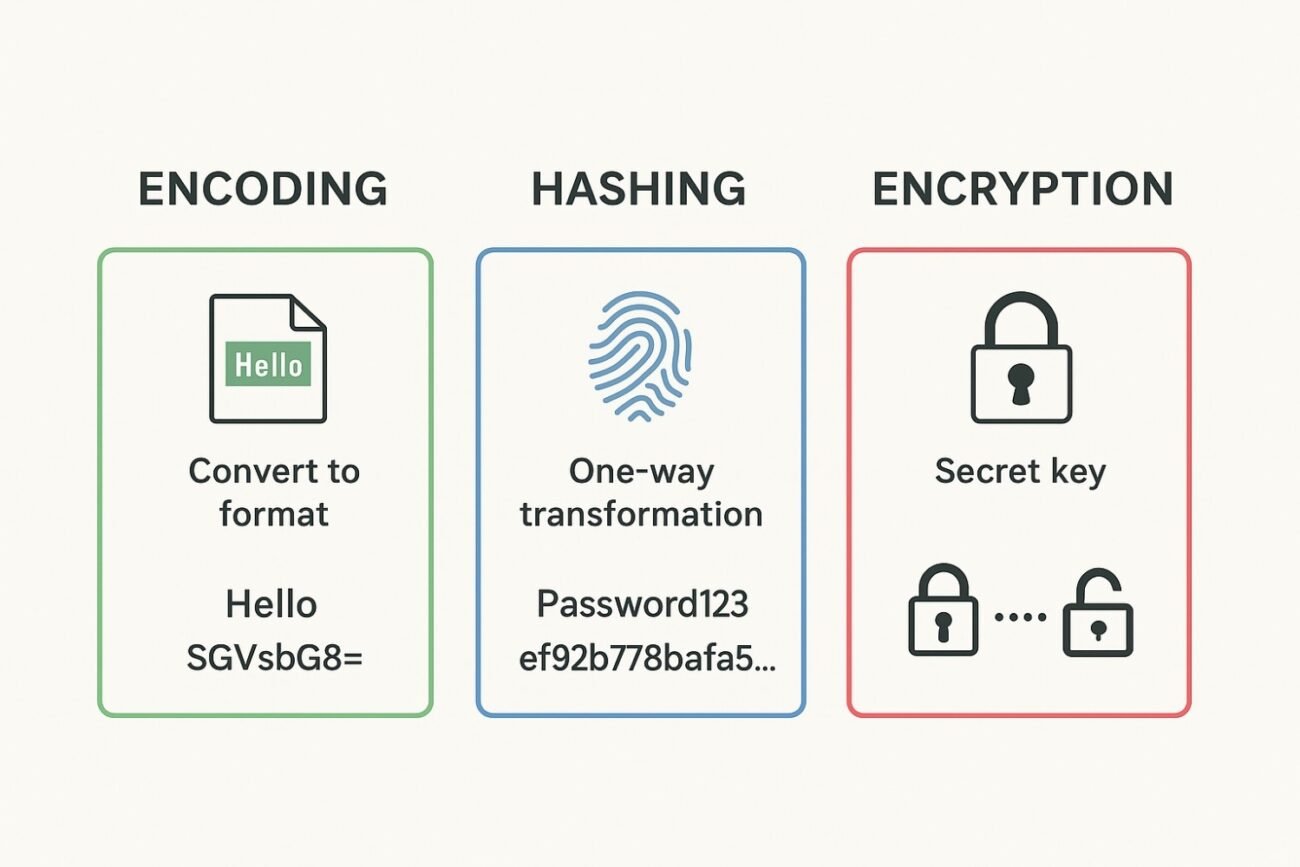🔹 Hashing in Swift (Password Example)
Purpose:
Hashing is used to verify data without revealing it directly. For example, when you log in with a password:
- The system never stores your real password.
- Instead, it stores a hash of your password.
- When you log in, the system hashes the entered password again and checks if the two hashes match.
Flow of password check with hashing:
- User registers → Password
"MySecret123"is hashed (say with SHA256) → stored in database.
Example stored:c9ef0d24d3...(hash string). - User logs in → Enters
"MySecret123". - App hashes this input again with the same algorithm (SHA256).
- Compare the new hash with the stored hash.
- ✅ If they match → Login success.
- ❌ If not → Wrong password.
🔑 Notice:
- Even if someone steals the database, they only get the hashes, not the original passwords.
- Hashing is one-way — you can’t reverse it.
Swift Example (SHA256):
import CryptoKit
func hashPassword(_ password: String) -> String {
let data = Data(password.utf8)
let hash = SHA256.hash(data: data)
return hash.compactMap { String(format: "%02x", $0) }.joined()
}
let storedHash = hashPassword("MySecret123")
// Save `storedHash` in DB
let loginHash = hashPassword("MySecret123")
// Compare `loginHash` == `storedHash`
Common Hashing Methods in Swift:
- SHA-256 (Secure Hash Algorithm 256-bit)
- Most commonly used cryptographic hash.
- Secure, widely accepted.
- SHA-512
- Stronger variant of SHA-256, but produces larger hashes.
- Used when extra security is needed.
🔹 Encoding in Swift
Purpose:
Encoding is about representation, not secrecy.
- Example: If you want to send an image or text over the internet, you encode it (Base64, JSON, URL-safe text) so the other system can understand it.
- Without encoding, data may break in transit (e.g., a special character might be misread).
If we didn’t use encoding:
- Sending binary files (like an image) via text-based systems (like JSON or HTML) would fail.
- Special characters (like
&,?,+) could be misinterpreted in URLs.
Swift Example (Base64):
let text = "Hello Swift!"
let data = text.data(using: .utf8)!
let encoded = data.base64EncodedString() // "SGVsbG8gU3dpZnQh"
let decoded = String(data: Data(base64Encoded: encoded)!, encoding: .utf8)!
// decoded = "Hello Swift!"Common Encoding Methods in Swift:
- Base64 → Convert binary to text (for safe transmission).
- URL Encoding → Replace unsafe characters in URLs (
Hello Swift!→Hello%20Swift%21). - JSON Encoding/Decoding → Convert objects ↔ JSON.
🔹 Encryption in Swift
Purpose:
Encryption ensures secrecy by scrambling data so only someone with the right key can read it.
- Unlike encoding, encryption requires a key.
- Unlike hashing, encryption is reversible (decrypt → original message).
Flow (e.g., chat message):
- User sends message
"Hello". - App encrypts with a key →
"9a8b23...". - Transmits encrypted text.
- Receiver decrypts with the same key →
"Hello".
Swift Example (AES):
import CryptoKit
func encryptMessage(_ message: String, using key: SymmetricKey) -> Data {
let data = message.data(using: .utf8)!
let sealedBox = try! AES.GCM.seal(data, using: key)
return sealedBox.combined!
}
func decryptMessage(_ encrypted: Data, using key: SymmetricKey) -> String {
let sealedBox = try! AES.GCM.SealedBox(combined: encrypted)
let decrypted = try! AES.GCM.open(sealedBox, using: key)
return String(data: decrypted, encoding: .utf8)!
}
let key = SymmetricKey(size: .bits256)
let encrypted = encryptMessage("Hello Swift!", using: key)
let decrypted = decryptMessage(encrypted, using: key)
// decrypted = "Hello Swift!"Common Encryption Methods in Swift:
- AES (Advanced Encryption Standard) → Fast, widely used.
- RSA (Asymmetric) → Public/Private key encryption.
- ChaCha20 → Modern alternative to AES.
Summary Table
| Concept | Purpose | Direction | Reversible | Example in Swift |
|---|---|---|---|---|
| Encoding | Format data for transmission/reading | Two-way | ✅ Yes | Base64, JSON, URL |
| Hashing | Verify integrity (e.g., passwords) | One-way | ❌ No | SHA256, SHA512 |
| Encryption | Protect secrecy with a key | Two-way | ✅ Yes (with key) | AES, RSA |
So,
- Encoding = Representation (safe transport)
- Hashing = Integrity (verification, not secrecy)
- Encryption = Secrecy (with keys)

